Your Complete Guide to:
Product-Led Storytelling: What It Is; How to Leverage It
You’ll learn what Product-Led Storytelling is. And how to leverage it to compel both investors and customers to buy your story and product.

Victor Eduoh
Lead Strategist, VEC

Ben Horowitz is a unicorn sniper.
As Co-founder of a16z, the multi-billion dollar VC firm, Ben has rare eyes for spotting top startups way before they become unicorns. Deel, Stripe, Instacart, Airbnb, Reddit, Plaid, and over a dozen other tech unicorns. Ben has invested in them all.
But for reasons best known to him...
Investor Ben Horowitz had no interest in investing in a 'community organizing tool.'
The Forbes report went on:
[But] a powerful, compelling, and well-told story caught Horowitz's attention and eventually led [Ben and a16z] to invest in NationBuilder, a startup that gives people the tools to organize communities online.
As a SaaS Founder or Marketing Leader, you may be thinking: Is a well-told founding story all I need to crack investors’ vaults?
Not quite.
Jim, and his team at NationBuilder, told…
A Story that’s Product-Led
Says the same Forbes article:
Horowitz also saw the stories of how people were using NationBuilder to mobilize communities to achieve great things they never could have done on their own. [Seeing stories of how people solved problems with the tool, Ben found] 'the whole story was incredibly compelling.'
Jim Gilliam’s founding story caught Ben’s attention. However, it was stories of how people were using the tool to solve problems that made it ‘incredibly compelling’ for him to invest.
You can achieve the same by telling, not just any story, but ones that are Product-Led. This is a strategy as old as the early ‘90s. To buttress, in his bestseller, ‘What the Dog Saw,’ Malcolm Gladwell traced the culture-shaping stories of US women using hair dyes.
An excerpt reads:

Malcolm’s book, and this story in particular, hit me hard:
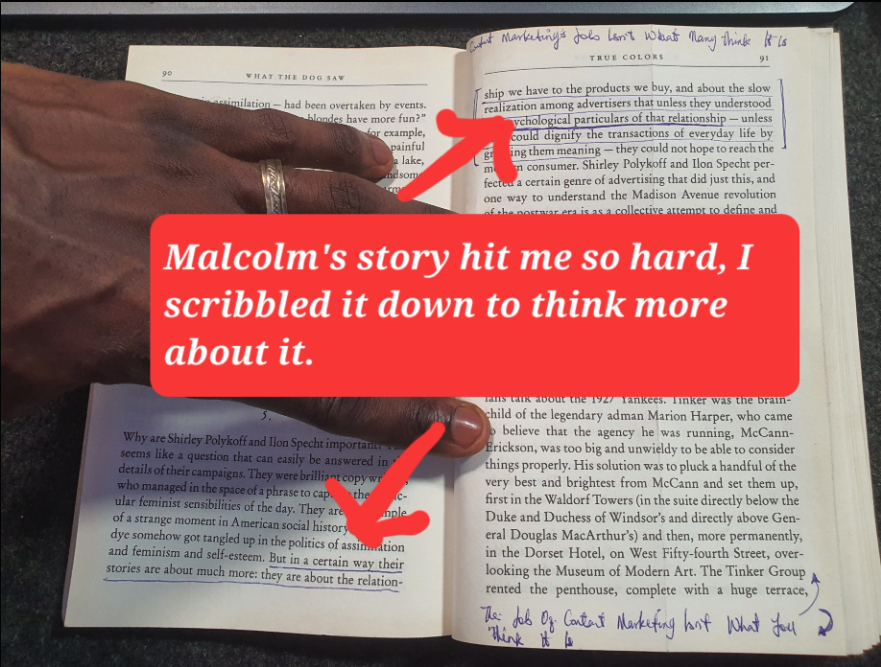
Along with similar ideas I penned from David Ogilvy’s ‘Confessions of an Advertising Man,’ it forced me to rethink B2B content marketing. It opened my eyes to how Tech Founders and B2B Marketers can leverage storytelling to earn mindshare and nudge prospects to buy software.
It led me to coin Product-Led Storytelling.
What is Product-Led Storytelling?
It is the art and science of using relatable stories to weave products into marketing content and copy. The goal is to show (and not just tell) target readers –your prospects and customers– how to solve problems or transform their lives with your product.
This storytelling approach is different. As we saw with Horowitz, it gives your marketing the superpowers needed to go beyond just capturing an audience’s attention. It’s structured to subtly educate prospects on making decisions that empower your sales team’s efforts.
On that thought train, April Dunford said:

But why should you even care about a storytelling structure that educates a buyer about how to make a decision? And by extension, why should you care about Product-Led Storytelling?
Two reasons.
It is…
1. A PLG & SLG Acquisition Enabler
In November 2022, Equals, the spreadsheet software that connects data to live dashboards, went the freemium, PLG route. If the acronym doesn’t ring a bell, PLG stands for Product-Led Growth.
Seven months later, in June 2023, they killed it, returning to their initial, SLG acquisition strategy. Pardon me if you’re also not familiar with the SLG acronym. It is short for Sales-Led Growth.
Bobby Pinero, their CEO, wrote:
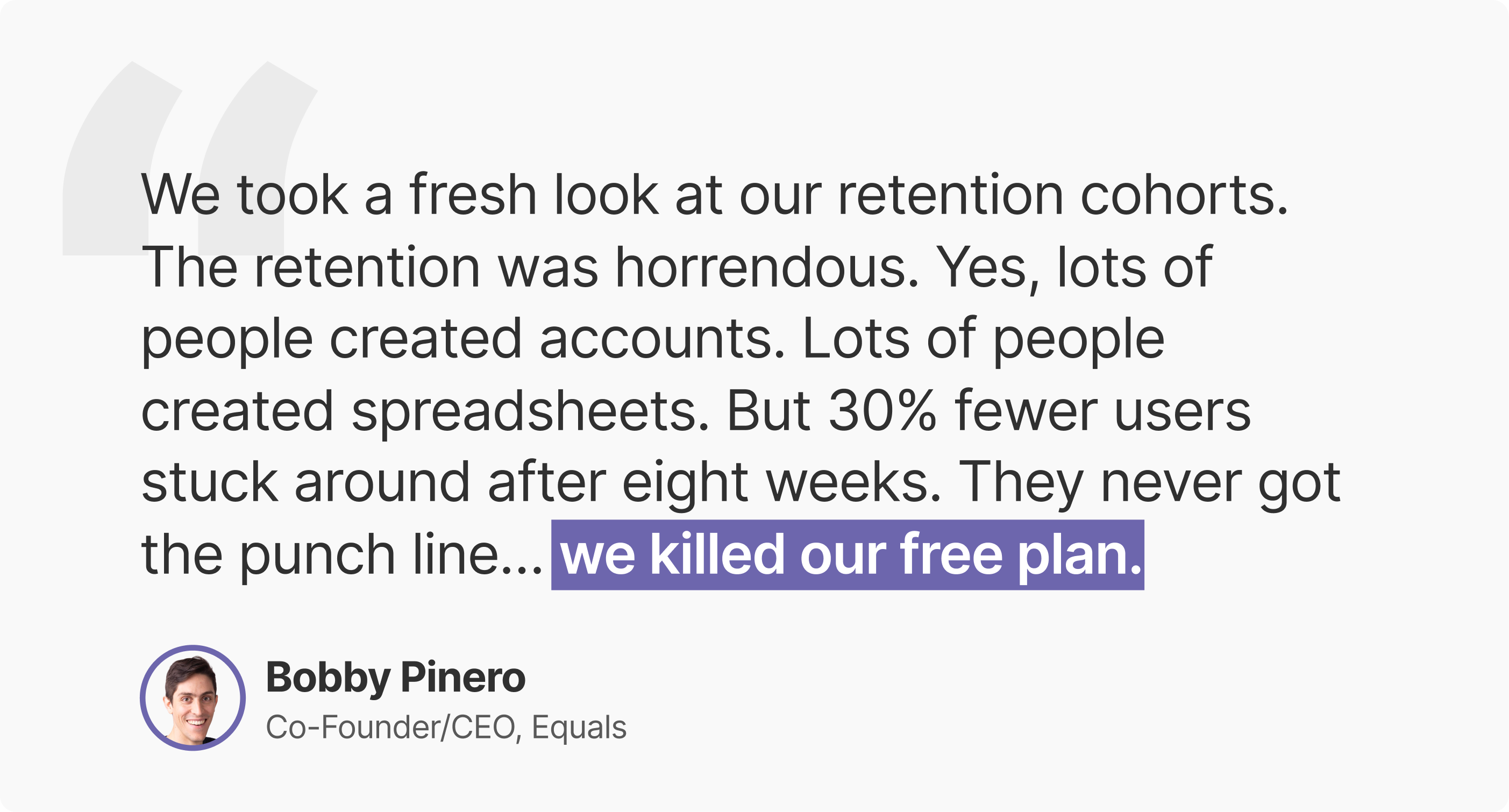
Here’s what they didn’t kill.
To acquire users on both sides, PLG and SLG, Equals created content showing (not just telling) readers and potential customers their product’s value. Take their ‘How to Establish Your Core Funnel’ piece published in April 2023, months after they went the PLG route:
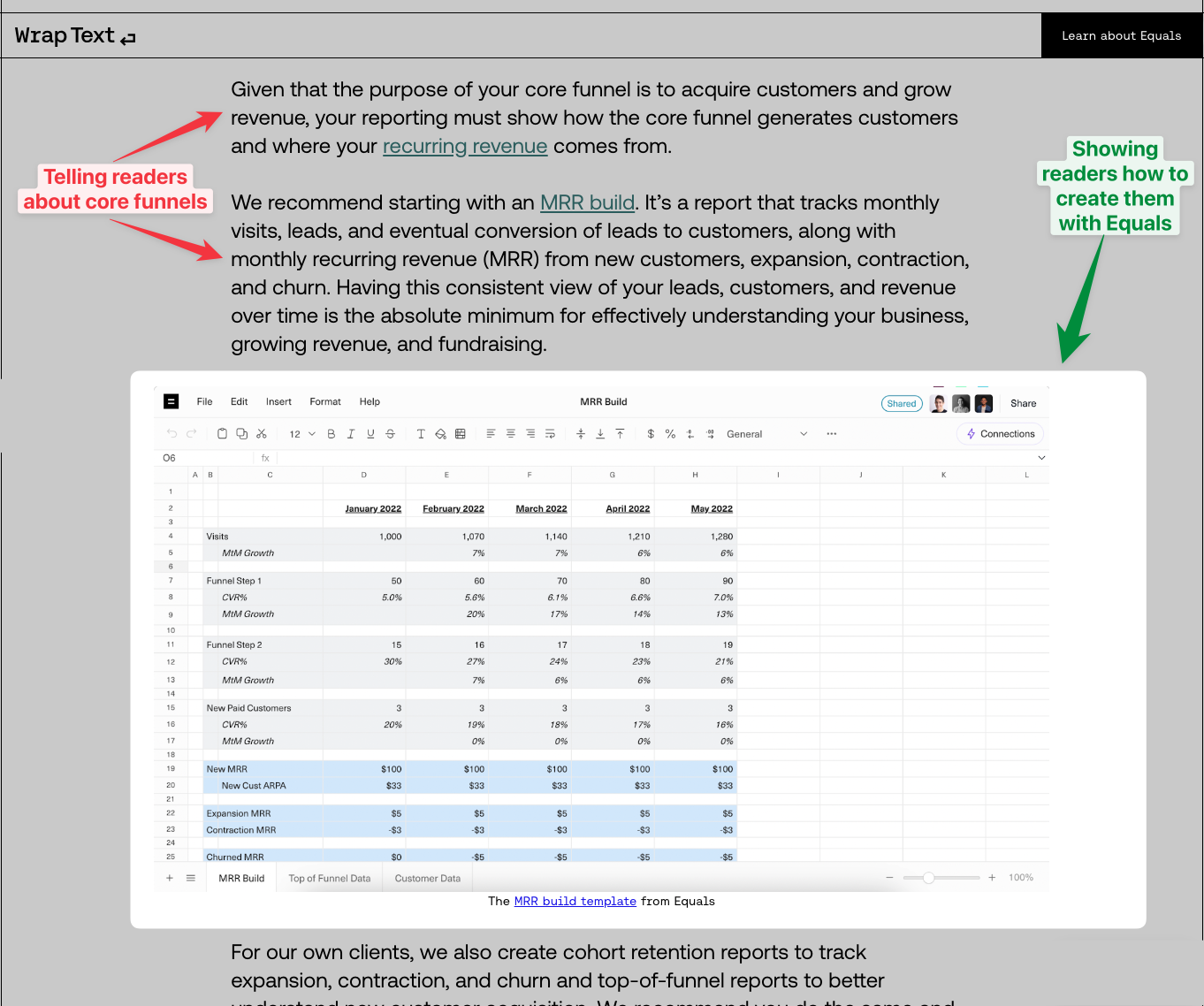
Returning to the SLG acquisition strategy, people needed to see value enough to key in credit card numbers for a trial. Equals is ticking that box by creating more story-driven content showing (not just telling) how their product solves problems. One, out of many, example is their ‘Because the World Needs Better Dashboards’ essay.
In it, they don’t just educate readers about dashboards, they share the story of how they build dashboards… with Equals:

The lesson?
Equals validates that content showing (and not just telling) people how to solve problems with your product drives acquisition. Craft them with stories target buyers can resonate with, and it’ll enable your freemium or sales-led acquisition motions.
That’s to say Product-Led Storytelling is also…
2. How You Oil the Modern SaaS Sales Funnel
The modern sales funnel is multifaceted.
Gone are the days when marketing, product, sales, and customer success worked in siloes. Today, to drive business metrics across acquisition, activation, and retention, every team owns KPIs:
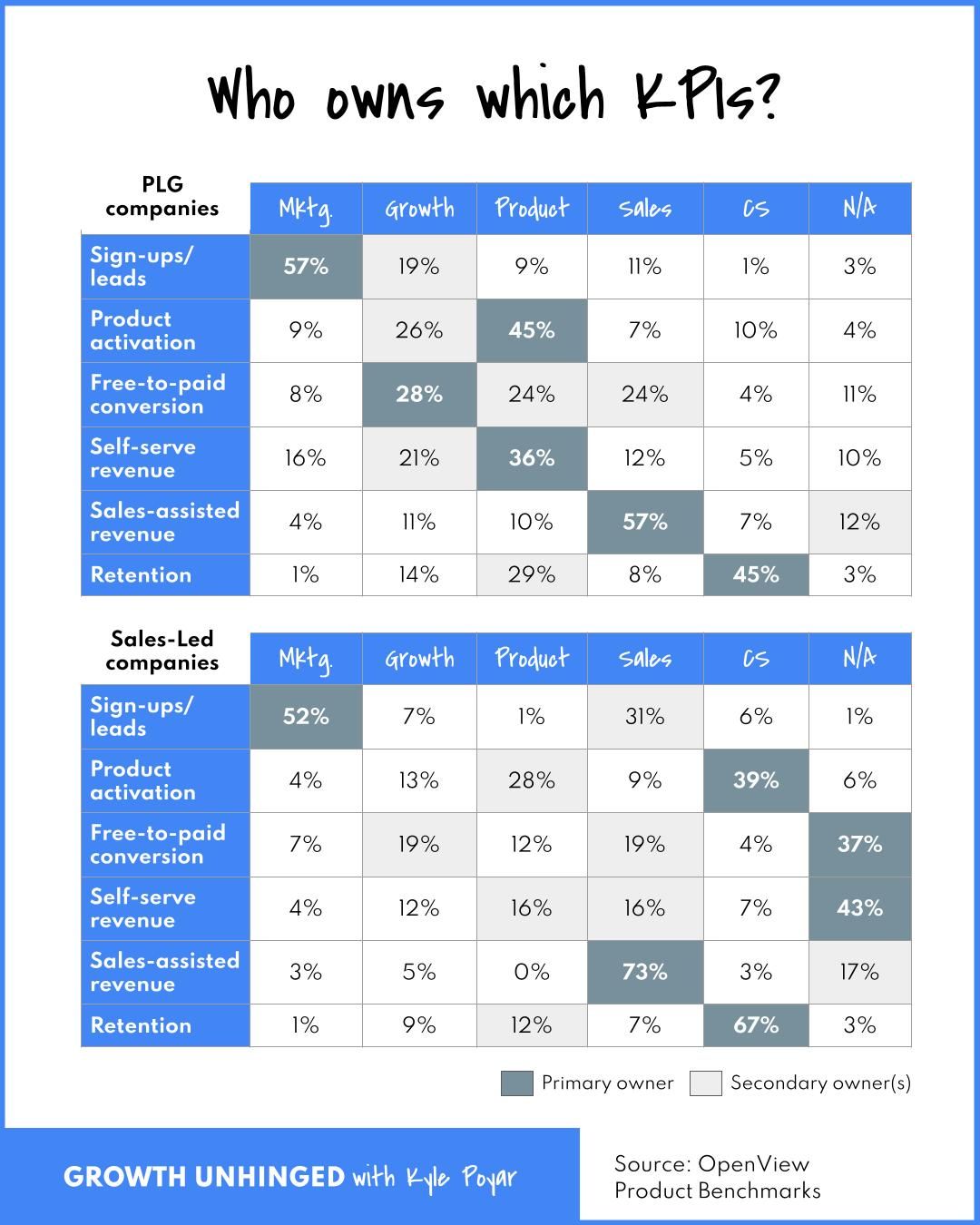
Experts behind the research above found what oils the modern SaaS sales funnel and drives lasting growth.
They discovered that:
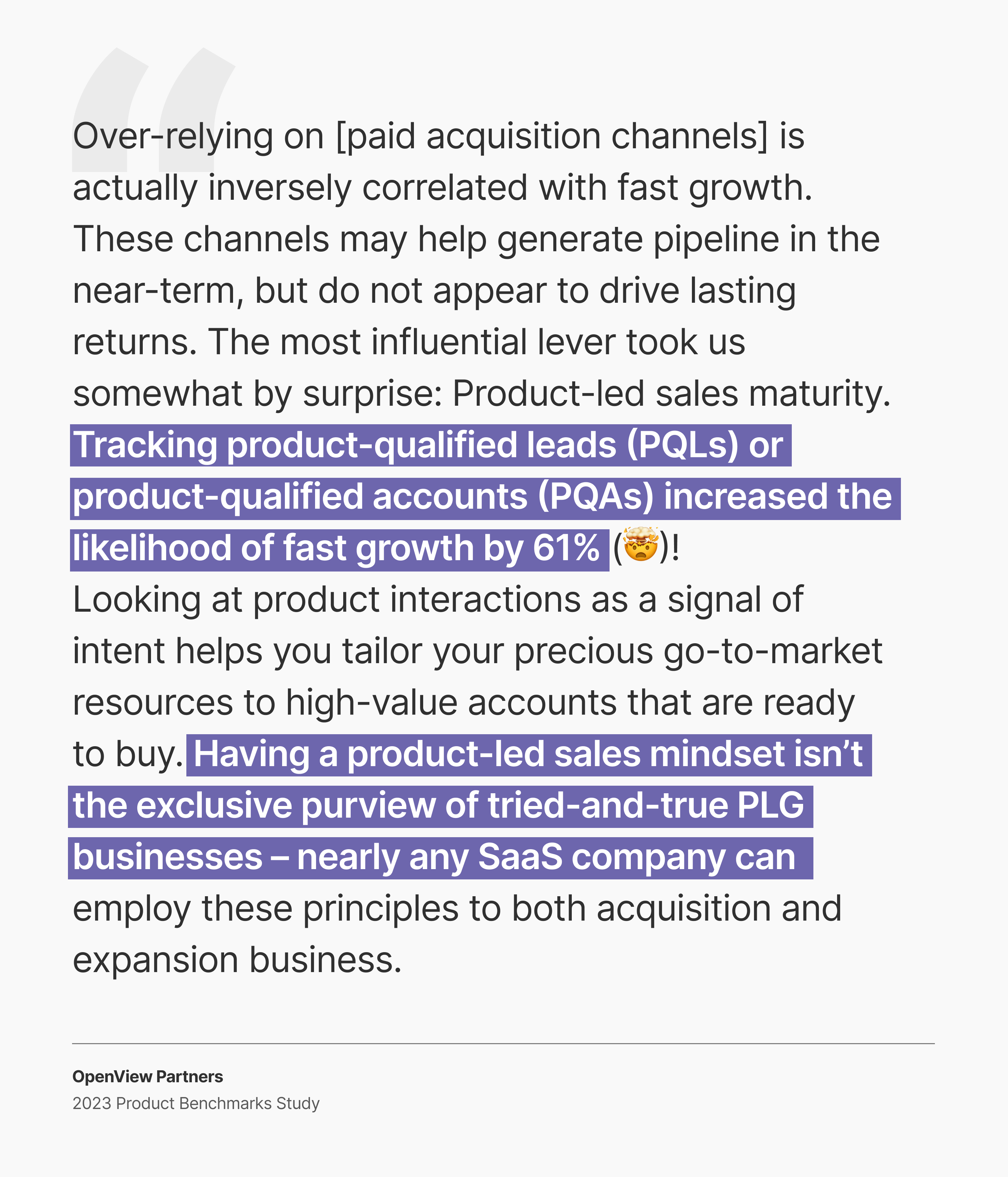
In other words, any SaaS business –PLG or SLG– is more likely to drive lasting growth by getting product-qualified leads (PQLs) into its funnel. The question then becomes: How do you attract, persuade, and get PQLs into your sales pipeline?
Recall how Ben Horowitz got attracted and persuaded against his stance and eventually invested in NationBuilder?
It’s probably why he said:

Using Product-Led Storytelling to show (not just tell) how to solve problems with your product doesn’t only make prospects perceive its value from afar. It also compels them to enter your sales funnel ready to start solving those problems they’ve seen how to solve, becoming PQLs in the process. All because you’ll be using stories they can relate with to make them visualize possible outcomes and get drawn in.
Our clients experience this.
One example is HoneyCart:
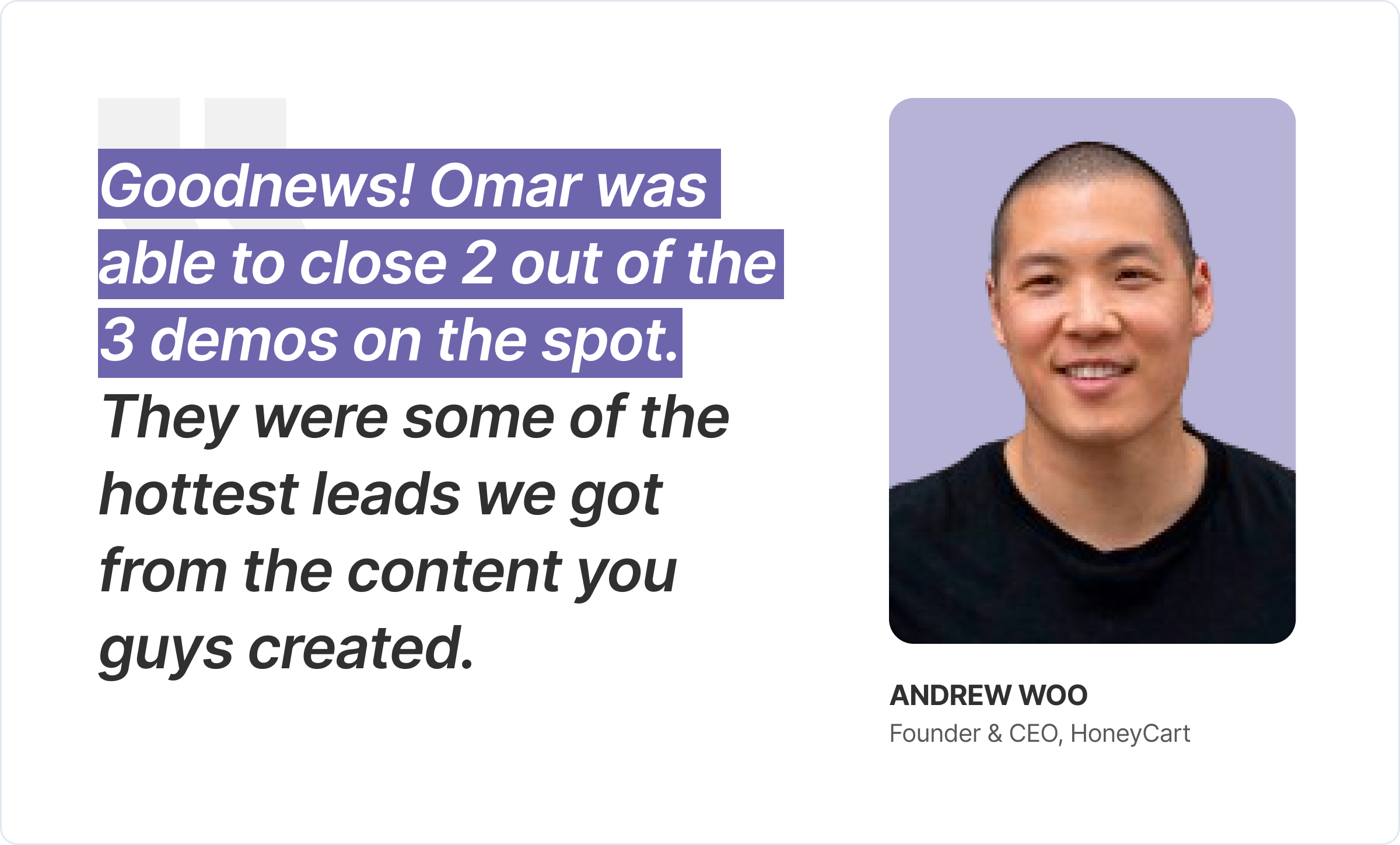
Read their success story here.
Product-Led Storytelling Execution Pillars
Before I proceed…
Enjoying this essay?
Then, you’ll love our newsletter:
Back to the essay.
To execute Product-Led Storytelling, do it really well, and achieve positive outcomes, three pillars must be erected.
1. Design an Overarching Company Narrative
Struggles and tensions, villains and heroes. The stories that make great movies are made of these. As it turns out, they are also the key to selling ideas, products, and building a lasting software business. So what tensions and struggles does your product alleviate? What villains does it slay and who exactly does it make heroes?
Your company narrative should answer those.
Again, Ben Horowitz:
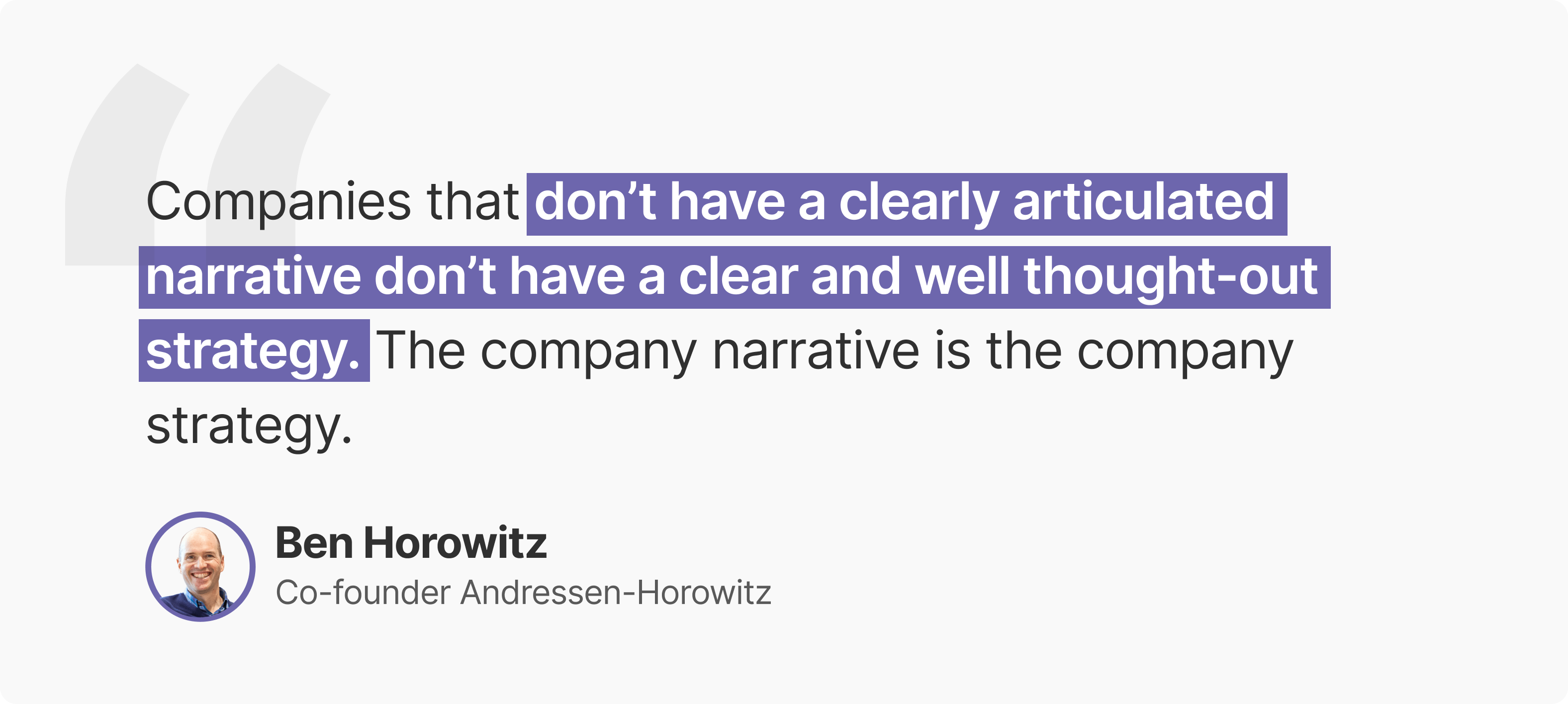
Having a narrative is a critical Product-Led Storytelling pillar. Let me tell you why. In today’s overcrowded SaaS industry, creating content that shows (not just tells) people how to solve their problems gives you an edge. But it’s not enough.
Say your competitors’ content also shows (and not just tells) how to solve problems. With identical product features and use cases, will prospects differentiate you from them?
That’s the main puzzle your company narrative tackles. It calls for you, the Leader, to step back and deeply reflect on the ‘whys.’ Specifically, query yourself thoroughly for factual answers to questions like:
- Why is my company doing this?
- Why does the problem(s) we solve need to be solved?
- Why should talented people join this company?
- Why should investors invest in this company?
- Why should potential customers buy (or investors invest in) our product over others?
Address these, and you’ll be on your way to an overarching company narrative that explains why your company [should] even exist. Why the world needs your company’s offerings. And why prospects will do themselves a disservice if they don’t solve the problems your company solves the way you solve them.
A lot goes into the mix.
In short, as crucial as everything laid out above are, they are only a small part of the equation (Honest Company Evaluation). And that’s per the framework we designed and leverage to help B2B SaaS startups design overarching company narratives:
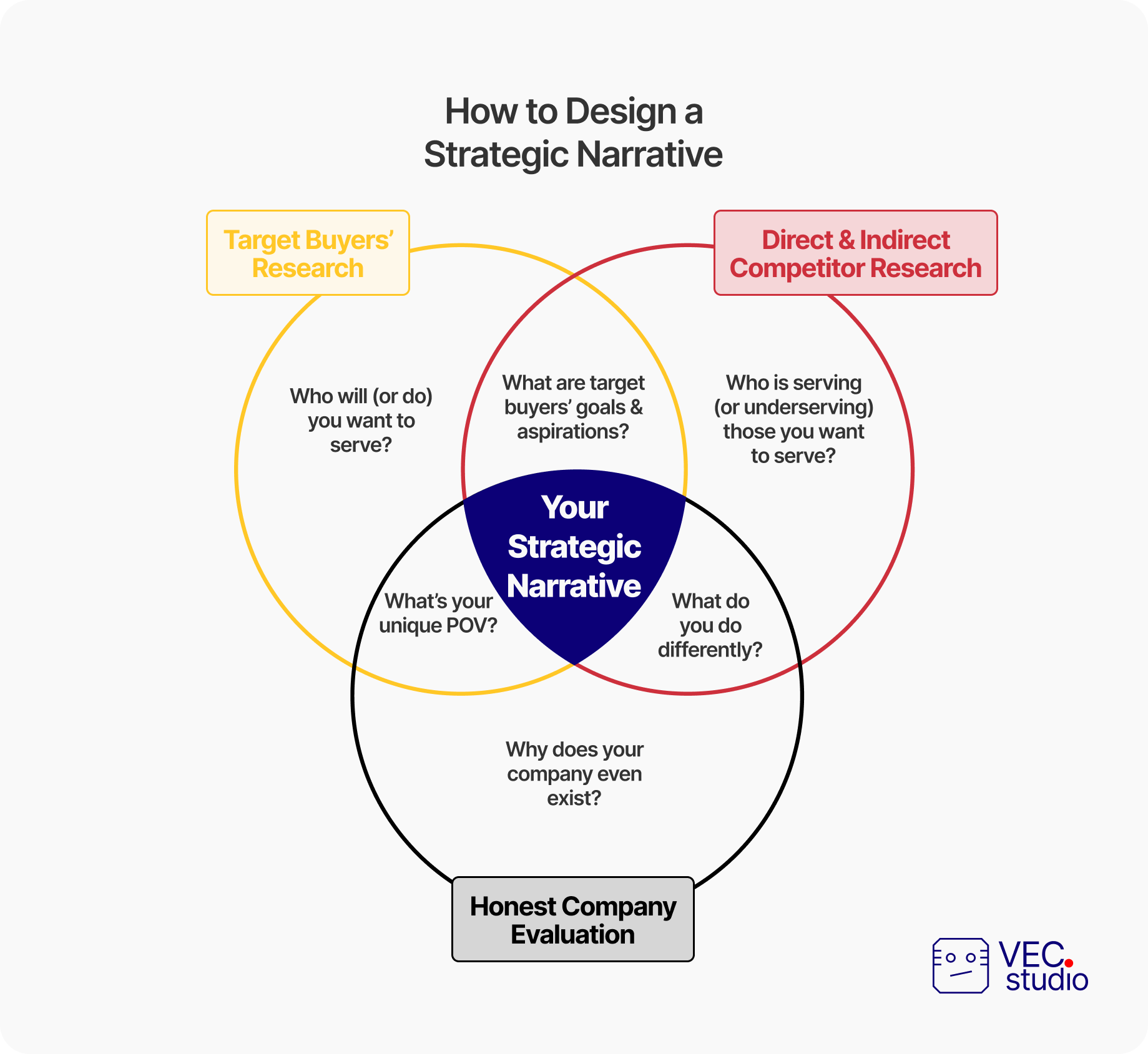
2. Build a Product-Led Content Marketing Strategy
Ready for a tradeoff?
Yes, there’s a tradeoff executing B2B content marketing programs with Product-Led Storytelling. The goal is getting product-led stories in front of your target buyers and in some cases, investors. This means you need to relax the focus on keywords or outranking competitors and treat SEO as just one distribution channel.
So, instead of a content marketing cluster of keywords around topics with the highest SEO search volumes, we do something different. To explain, take the TCCS (Topic Clusters Content Strategy) Framework we built and use to help our B2B SaaS clients with this:
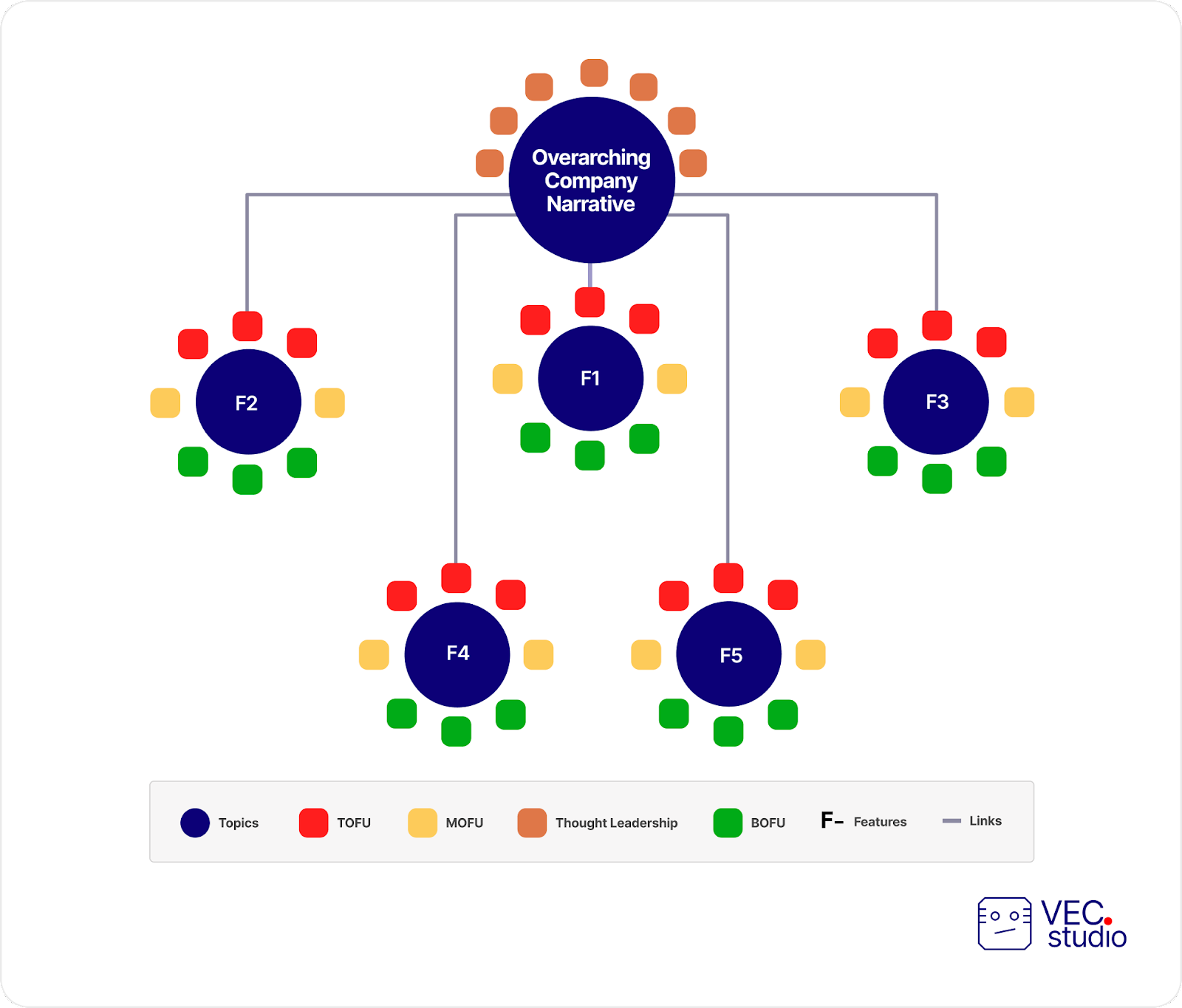
As illustrated, you should:
- Have your company narrative top and center
- Choose core product features as strategy pillars
- Research queries and buyer pain points related to the problems each core product feature solves (this should be ongoing).
- Use those queries and pain points to cluster content ideas around each feature per the customer journey.
- Build your content and Product-Led Storytelling plan by prioritizing the stories worth crafting first.
The points above are by no means exhaustive.
For instance, in the TCCS Framework above, notice ‘Thought Leadership’ is clustered around the company’s overarching narrative. That’s because when building a Product-Led Content Marketing Strategy, you need a bucket of ideas for crafting Product-Led Stories amping your narrative and downplaying those of competitors.
To source these ideas:
- Research objecting queries to your company narrative and points of view
- Brainstorm queries supporting your narrative and unique points of view
- Outline queries countering competitors offering relative to yours
- Scrape competitors’ positioning queries and brainstorm content ideas for opposing or poking holes into them.
These should make up your first bucket of content ideas.
They need equal footing in your Product-Led Storytelling execution plan because they help you solidify your market position and differentiation. And the second and third bucket of content ideas?
The second should come from researching queries and pain points related to the problems each core product feature solves. Think of this as acquisition-focused content ideas. The third bucket, ideas for crafting content for existing users/customers, often gets ignored.
John Ellet shared why it shouldn’t:
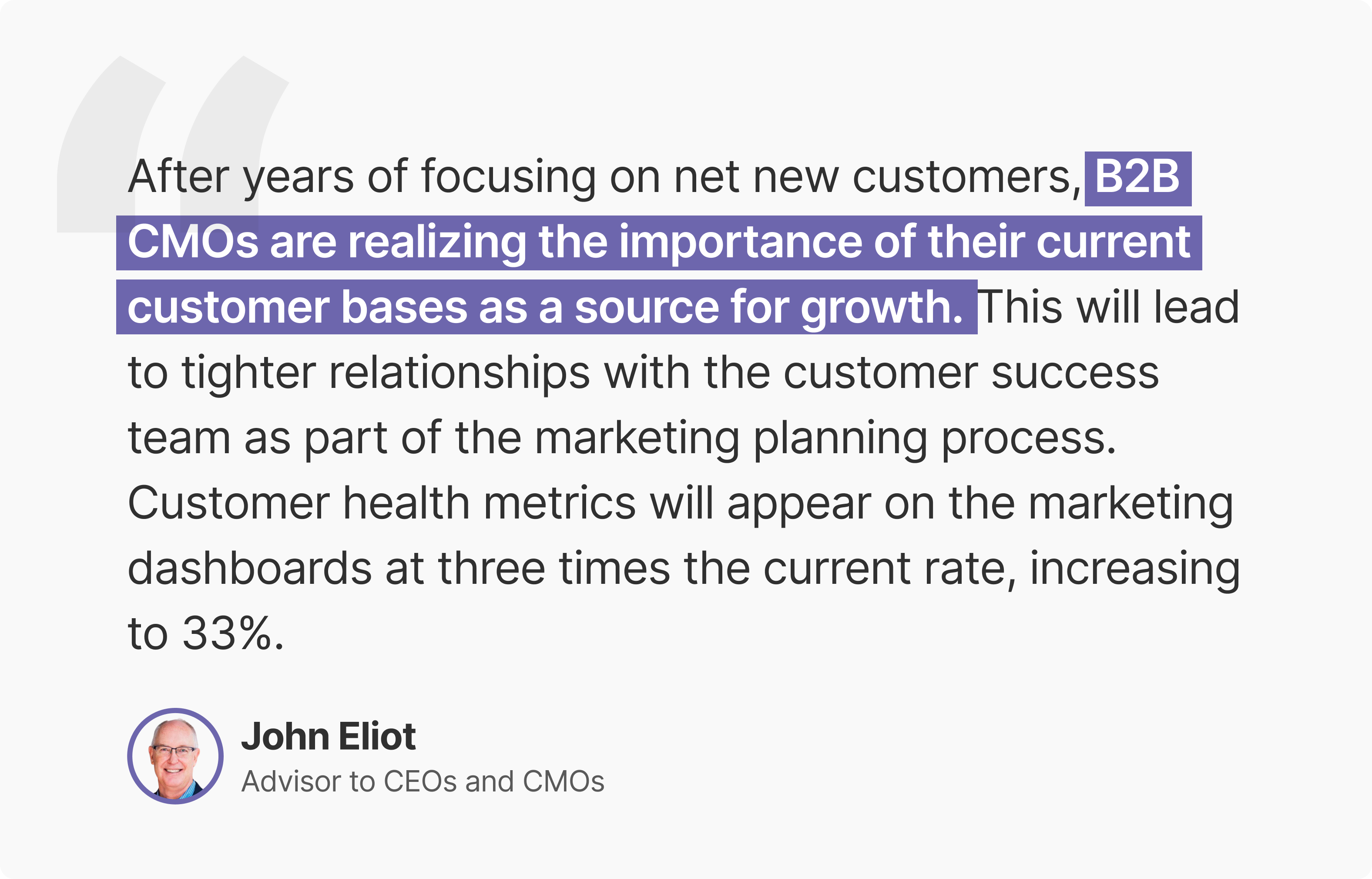
The first and second buckets of content ideas will help your marketing team acquire users (i.e., PQLs) and customers. The 3rd is equally important for converting free users, nudging paying customers to expand their accounts, and turning them into advocates.
At VEC, we build Product-Led Content Marketing strategies, using these three buckets of content ideas.. This, in turn, enables using Product-Led Storytelling to craft:
- Thought leadership that amplifies company narratives and educates the market about how a product is different
- How-to guides that shows (not just tells) target buyers how to solve their problems with specific features of a product
- Sales enablement content that empower sales team to close PQLs and expand accounts much faster:
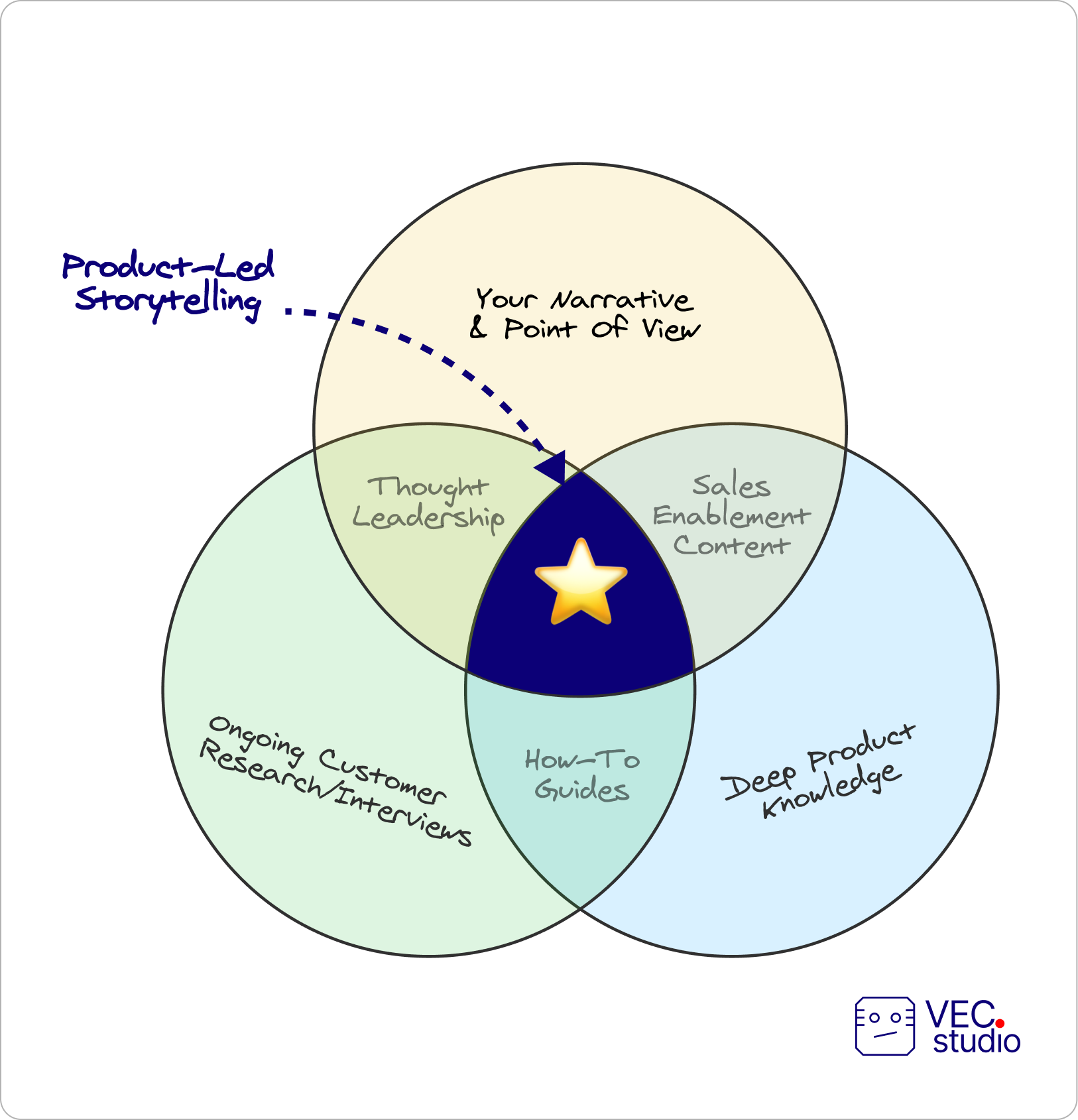
It doesn’t end there.
There are other crucial things we do before we start crafting content. For instance, we design an information architecture, ensuring new content pieces are strategically linked. As part of this, we design and create landing page copy for each core feature. Doing this enables your team to smoothen the customer journey path from content to conversion-optimized pages.
An example is the feature-specific cluster we designed for our client, WriterZen. Since AI writing is one of their product’s core features, we wrote the landing page copy and clustered content ideas around it.
Here’s an illustrated sample:
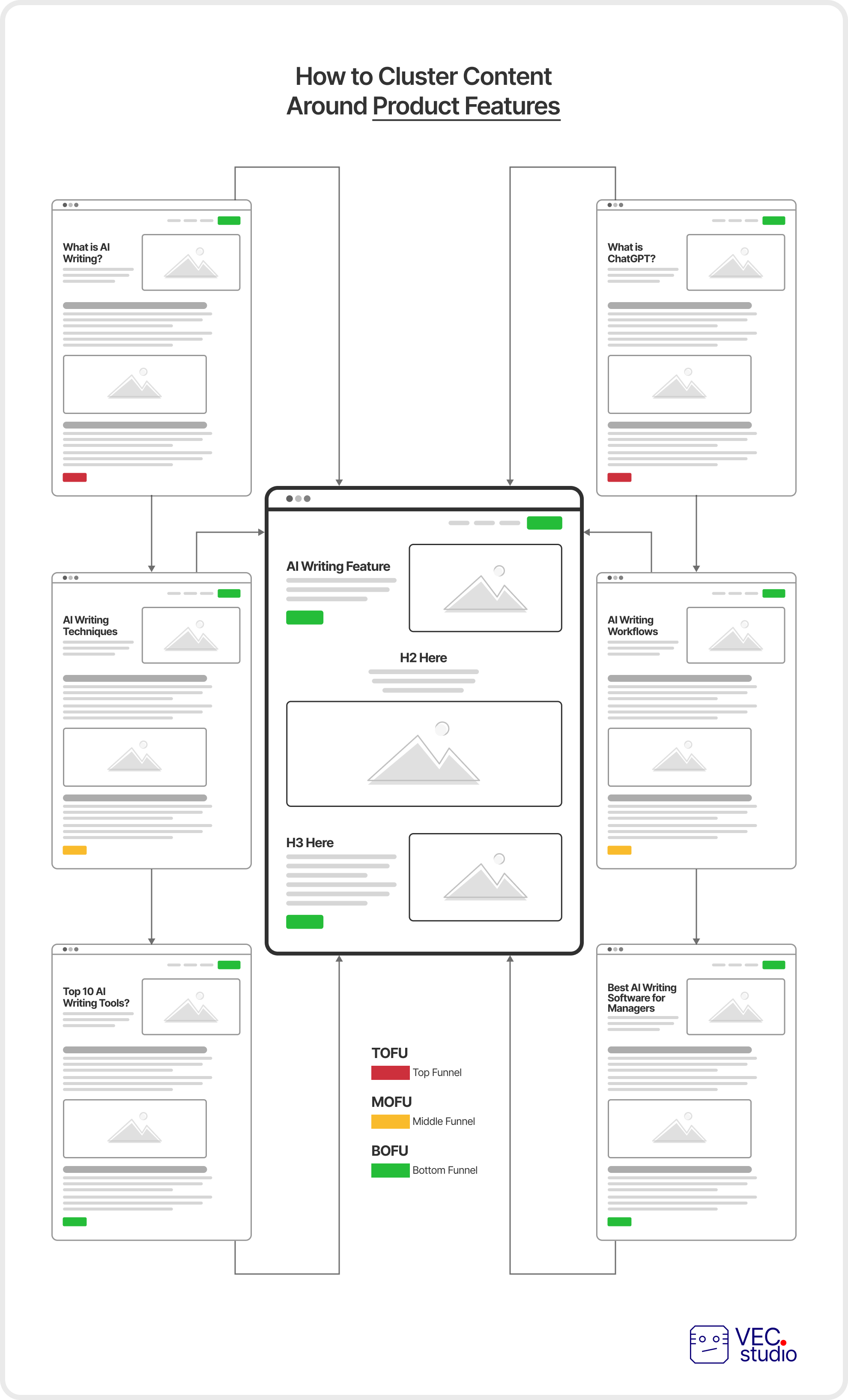
The sample cluster above involved:
- Writing copy and designing a conversion-optimized landing page for the feature, AI Writing.
- Writing top of funnel pieces (‘what is AI writing,’ ‘what is ChatGPT,’ etc.) and linking them to the feature landing page and middle of the funnel pieces.
- Creating middle of funnel pieces (‘AI writing techniques,’ ‘AI writing workflows,’ etc.) and linking them to the feature landing page and bottom of the funnel pieces.
- Crafting bottom of funnel articles (‘top 10 AI writing tools,’ ‘best AI writing software for managers,’ and so on) and linking them to the feature landing page.
A quick video explainer:
As I show in the video above, these steps help you clusters content ideas in a way that achieves smooth customer journeys to your core feature pages.
It looks like this:
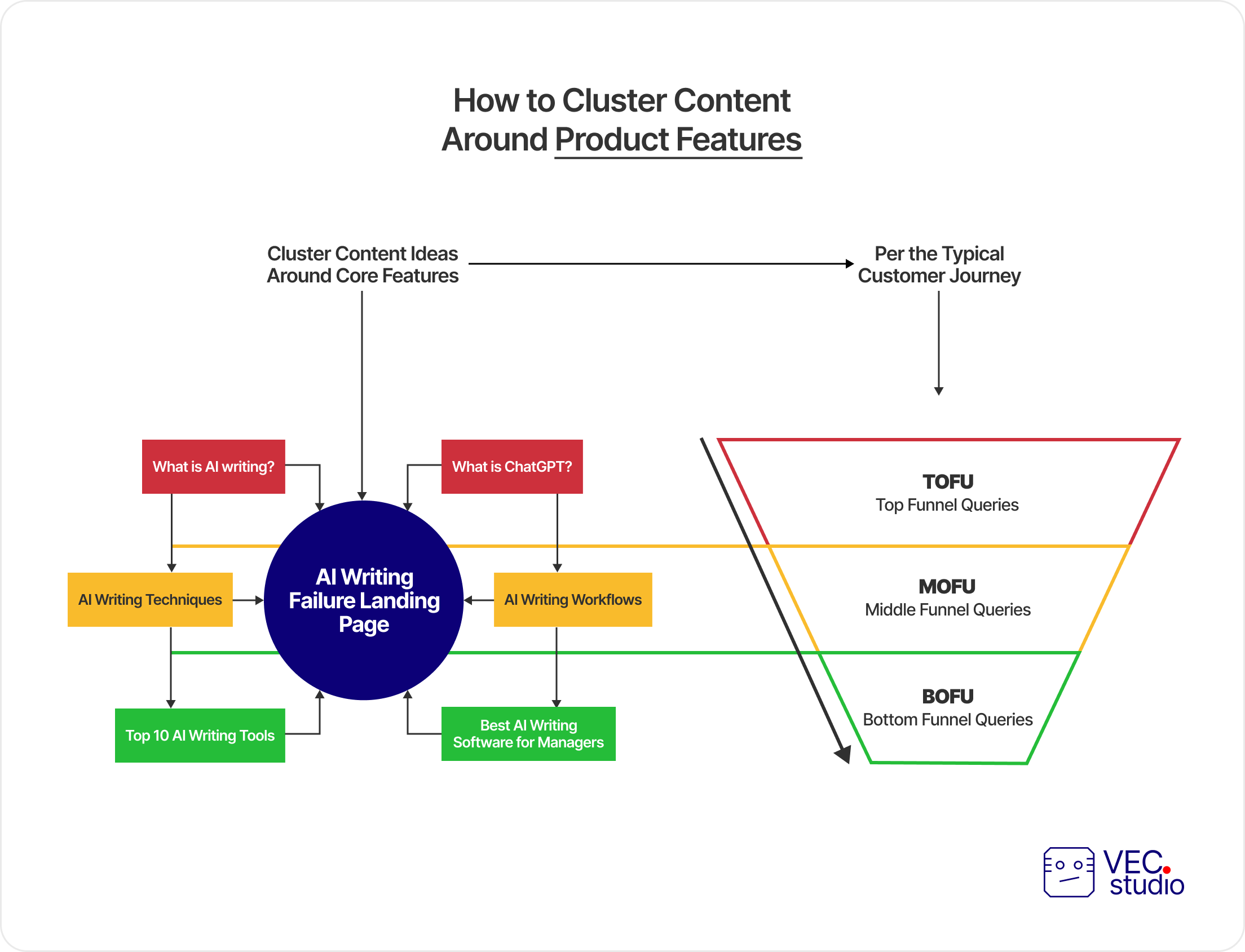
Doing all of the above, and more I haven’t mentioned, is a non-negotiable pillar for executing Product-Led Storytelling. It is how we design praise-worthy, Product-Led Content Strategies.
Talking about praise-worthy…
A happy client of ours said:
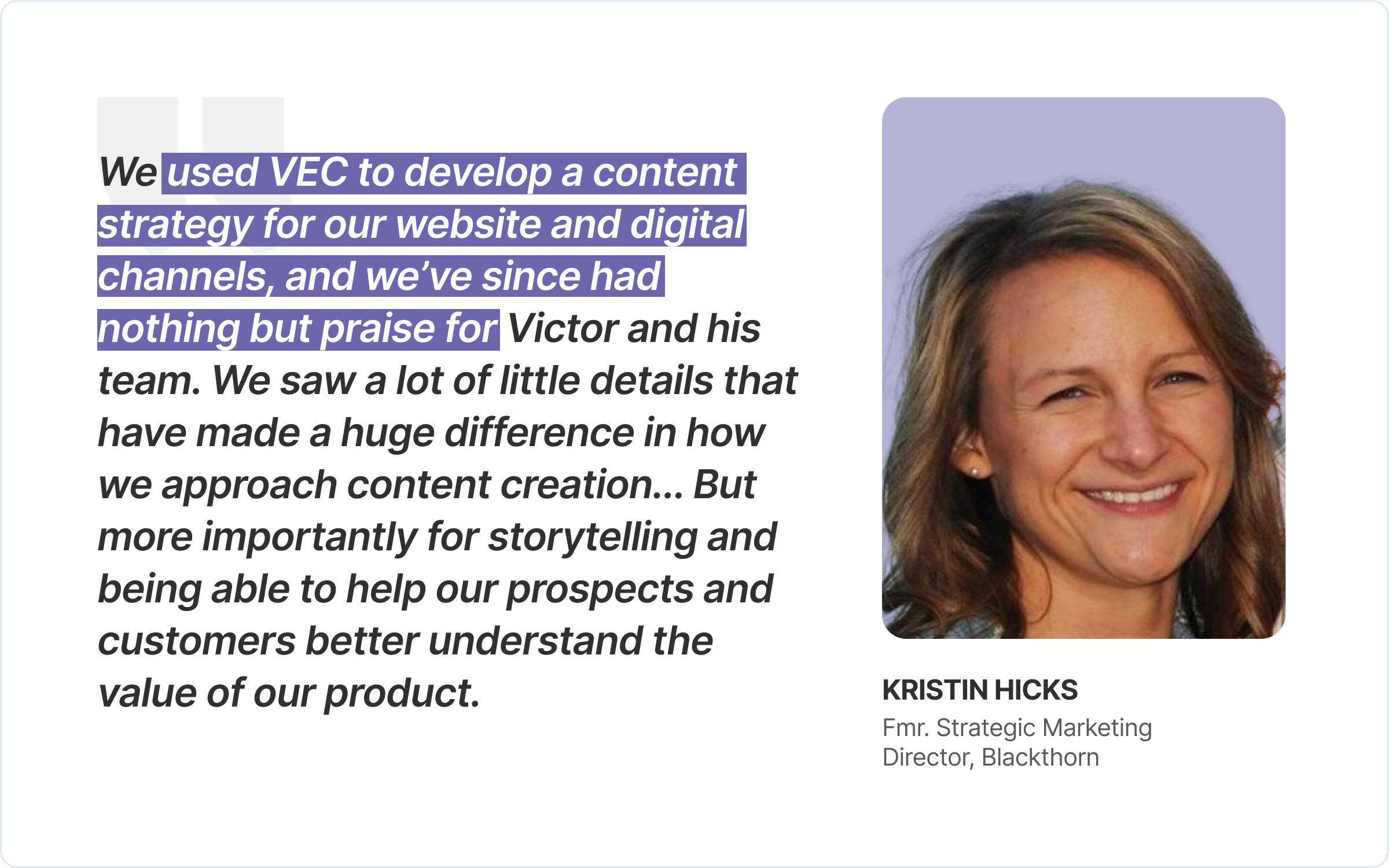
If the steps to designing an effective Product-Led Content Marketing Strategy seems like a lot, it’s because it is. And from my experience working with many B2B SaaS startups, most get it all wrong.
That’s why I’m building an A-Z course walking through everything you need –tools, processes, frameworks, and templates.
Join the waitlist below:
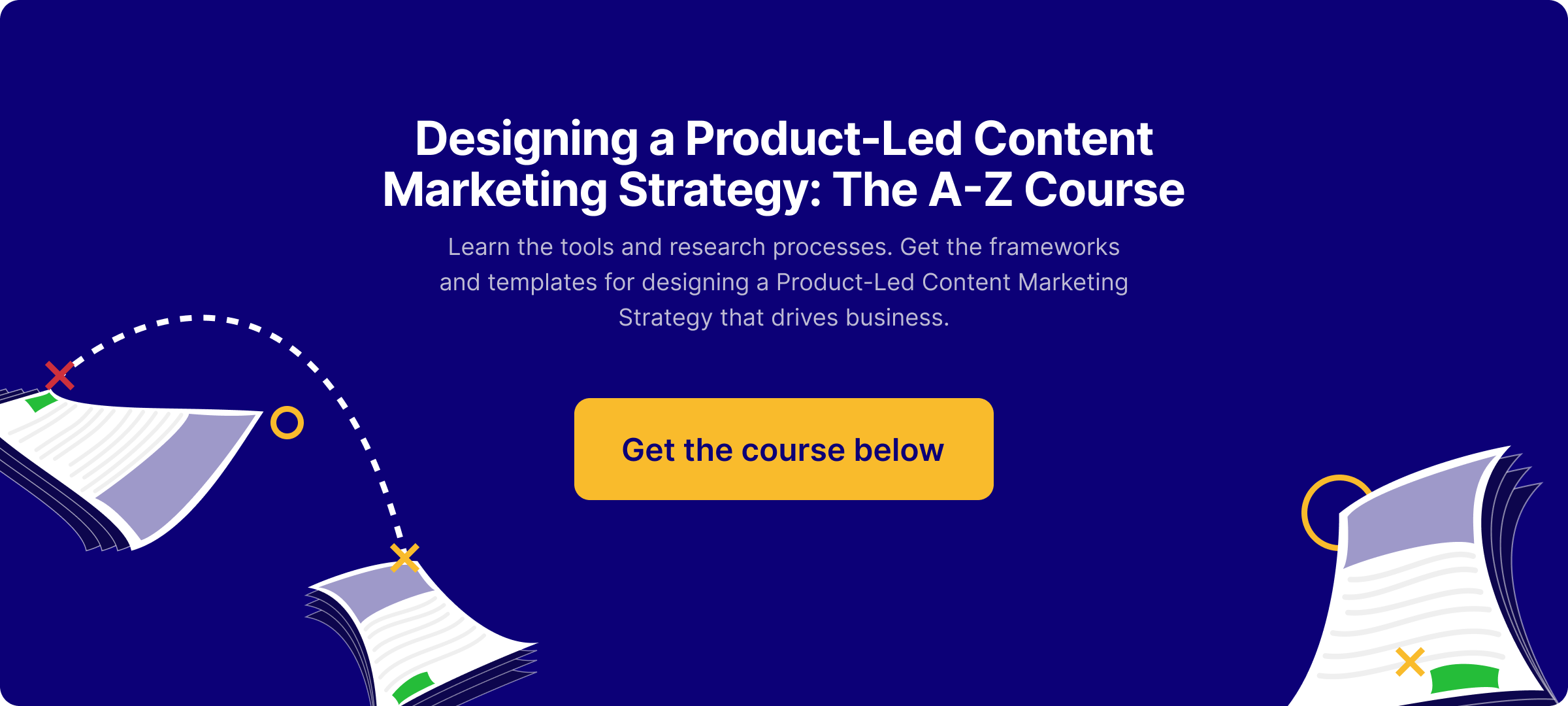
Join the online course waitlist here.
3. Obsess Over One Person at a Time
This Product-Led Storytelling execution pillar often sounds counterintuitive: Obsess over one person at a time?
Mentees and clients roll their eyes when I first say it to them. And their usual reaction is: Why obsess over one person when we need to reach and convert as many as people into paying customers?
David Ogilvy said it best:
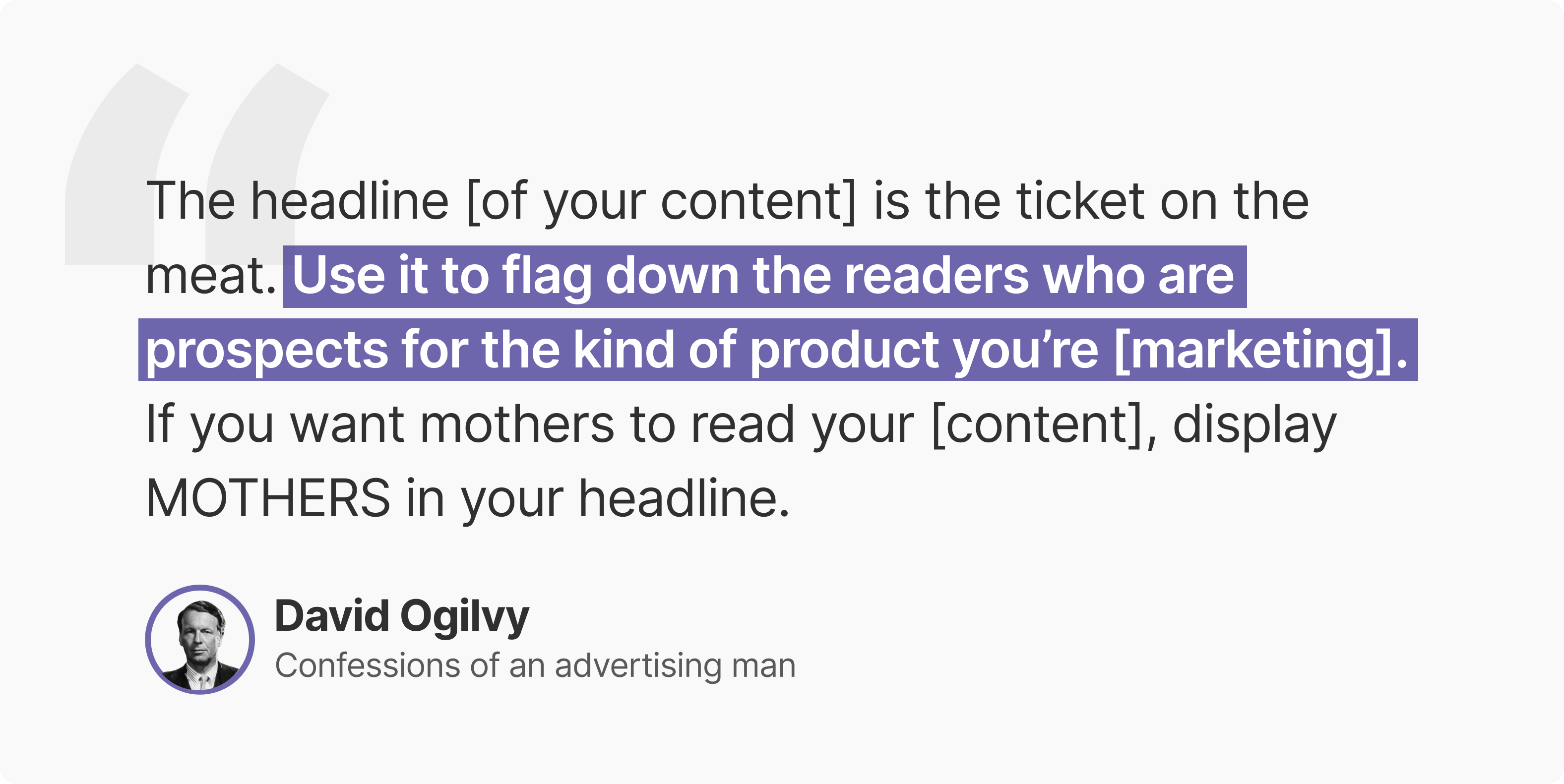
Examine these headlines:
- “6 Best Sales Productivity Tools for AEs Using Salesforce”
- “Capturing Organic Search Demand: A Content Manager’s Guide”
- “A Manager’s Guide to Instilling Passion in the Workplace”
- “Busy CTOs’ Checklist for Automating GDPR Compliance”
- “Post-COVID Profits: 5 Experts Share How Caterers Can Bounce Back with Over $45k/Year In Savings”
These are live work samples of articles we crafted for our clients, People AI, WriterZen, ShowUp, Cyber Sierra, and HoneyCart, respectively. Can you notice the commonality among them all?
They’re all flagging down one particular person:
- The 1st flags down ‘AEs using Salesforce’
- The 2nd flags down ‘Content Managers’
- The 3rd flags down ‘Managers’
- The 4th flags down ‘CTOs’
- And the 5th ‘Caterers.’
I wrote a whole essay detailing why obsessing over, and crafting content for one person at a time, is so crucial. I could spend an entire day telling you why your team shouldn’t do otherwise.
But John Steinbeck said it better:
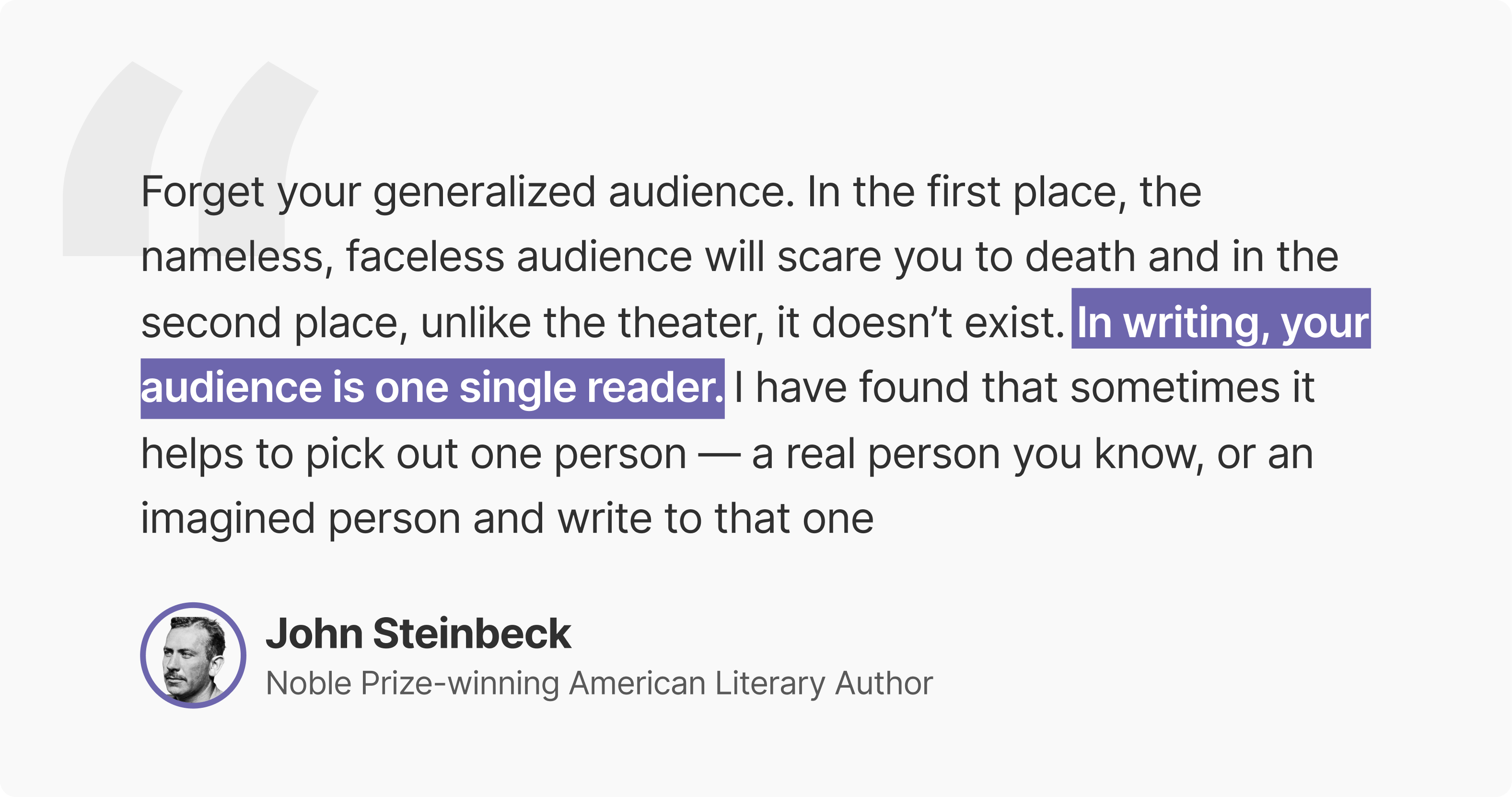
Product-Led Storytelling embodies this advice.
Recall its definition, “...the art and science of using relatable stories to weave products into marketing content and copy.” By ‘relatable stories,’ we mean crafting content that resonates with very specific target readers (i.e., potential customers) right off the bat.
It is how get Tech CEOs into VEC’s pipeline:
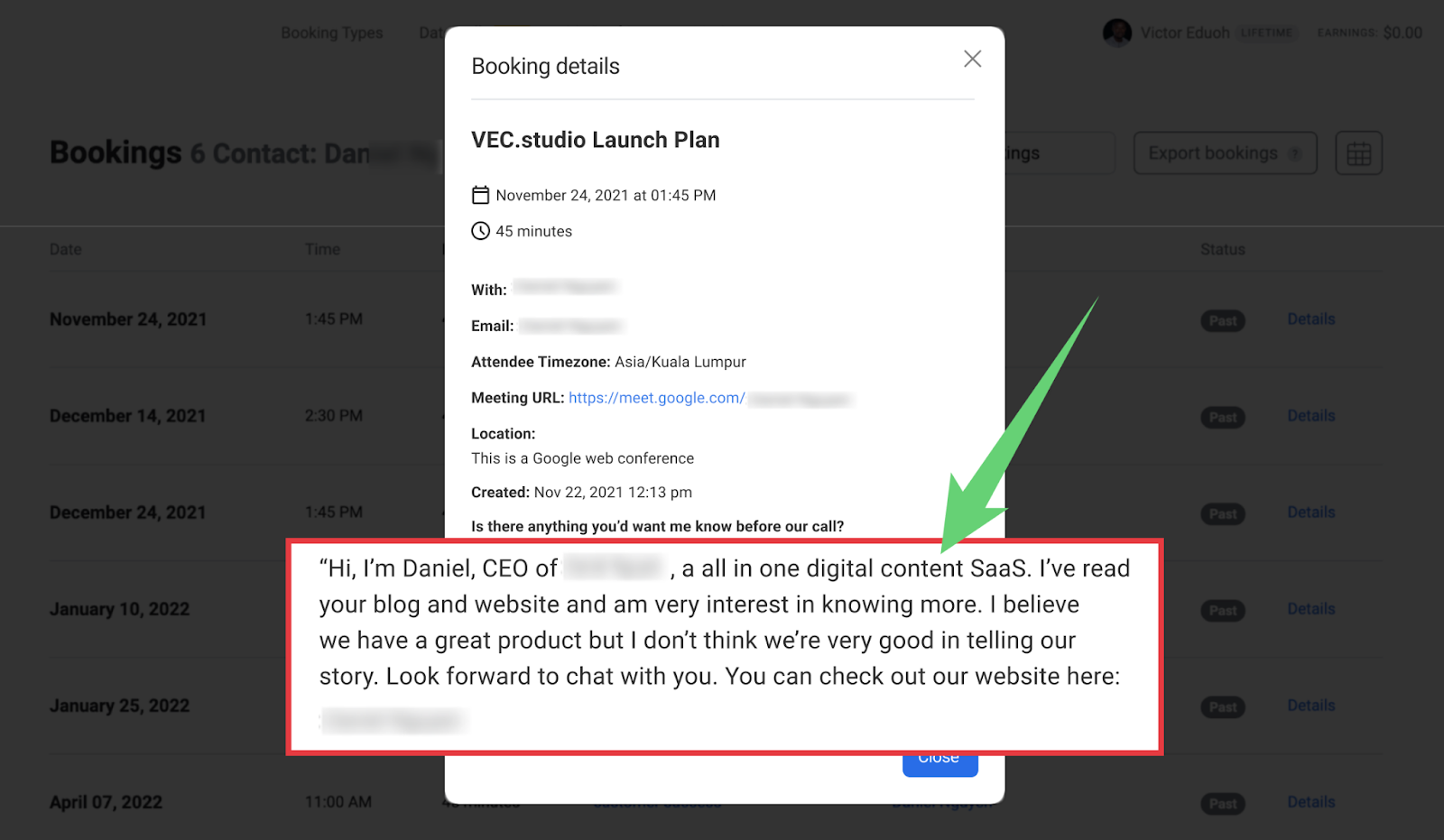
It’s also how we craft story-driven content that pulls in product-qualified leads (PQLs) our clients close more easily into their sales pipelines.
But don’t take it from me:
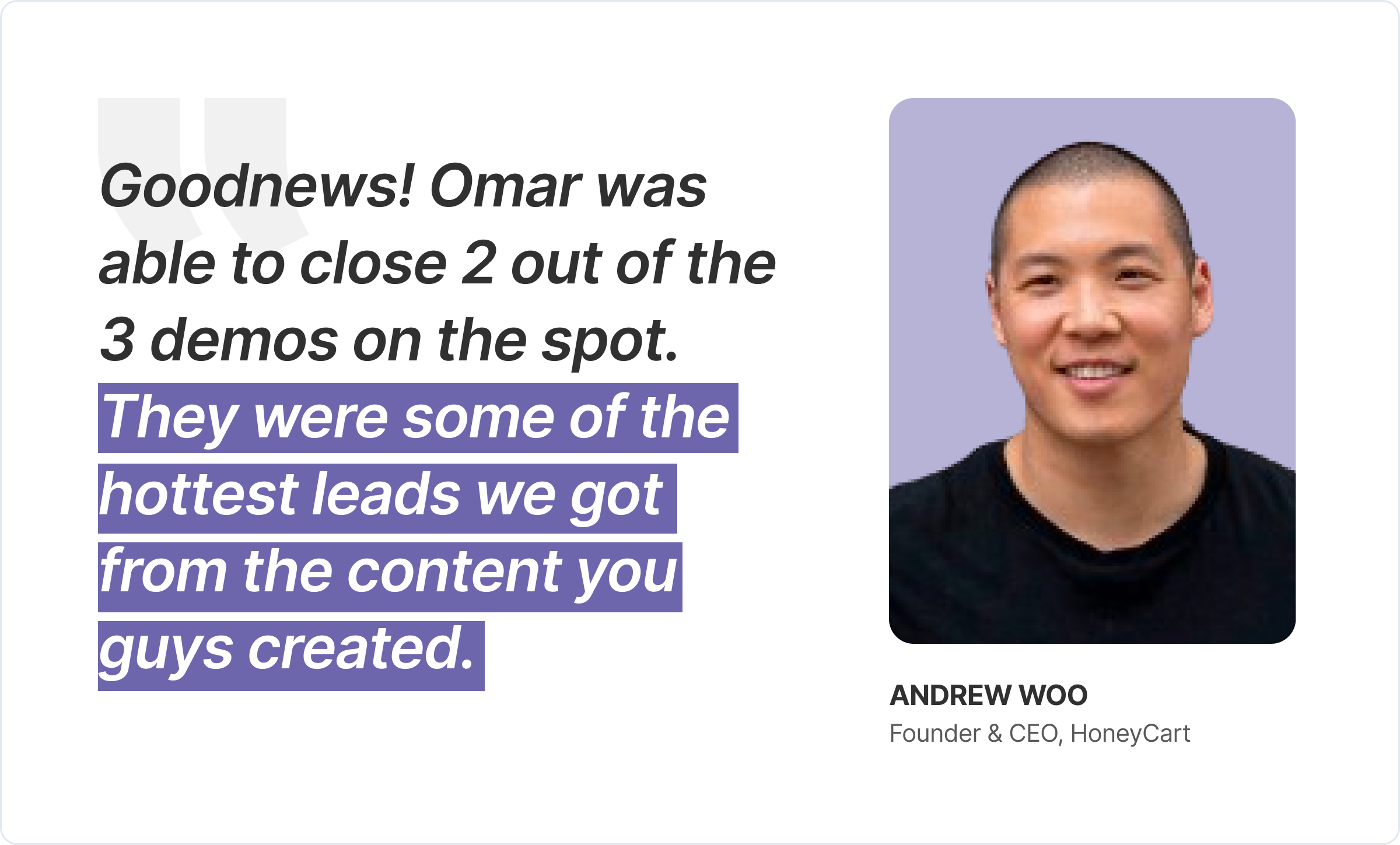
As the results above show, obsessing over one person at a time is another non-negotiable Product-Led Storytelling pillar. It provides the guardrails needed to choose the stories to tell when crafting content, the features and product examples to show, and the possible outcomes target readers stand to gain if they used your product.
When we first realized that, for Product-Led Storytelling to work, we needed to obsess over one person at a time, we faced challenges.
Two challenges, to be specific.
I’ll start with the first.
Using either buyer personas or JTBD (jobs to be done) didn’t help us to craft story-driven content that resonated with WHO target readers are and WHAT problems a product could solve for them. And when you don’t resonate with a reader, you can’t compel them to act.
To solve this, we combined both (buyer personas and JTBD), arriving at ICP StoryScripts, a new framework that works way better:
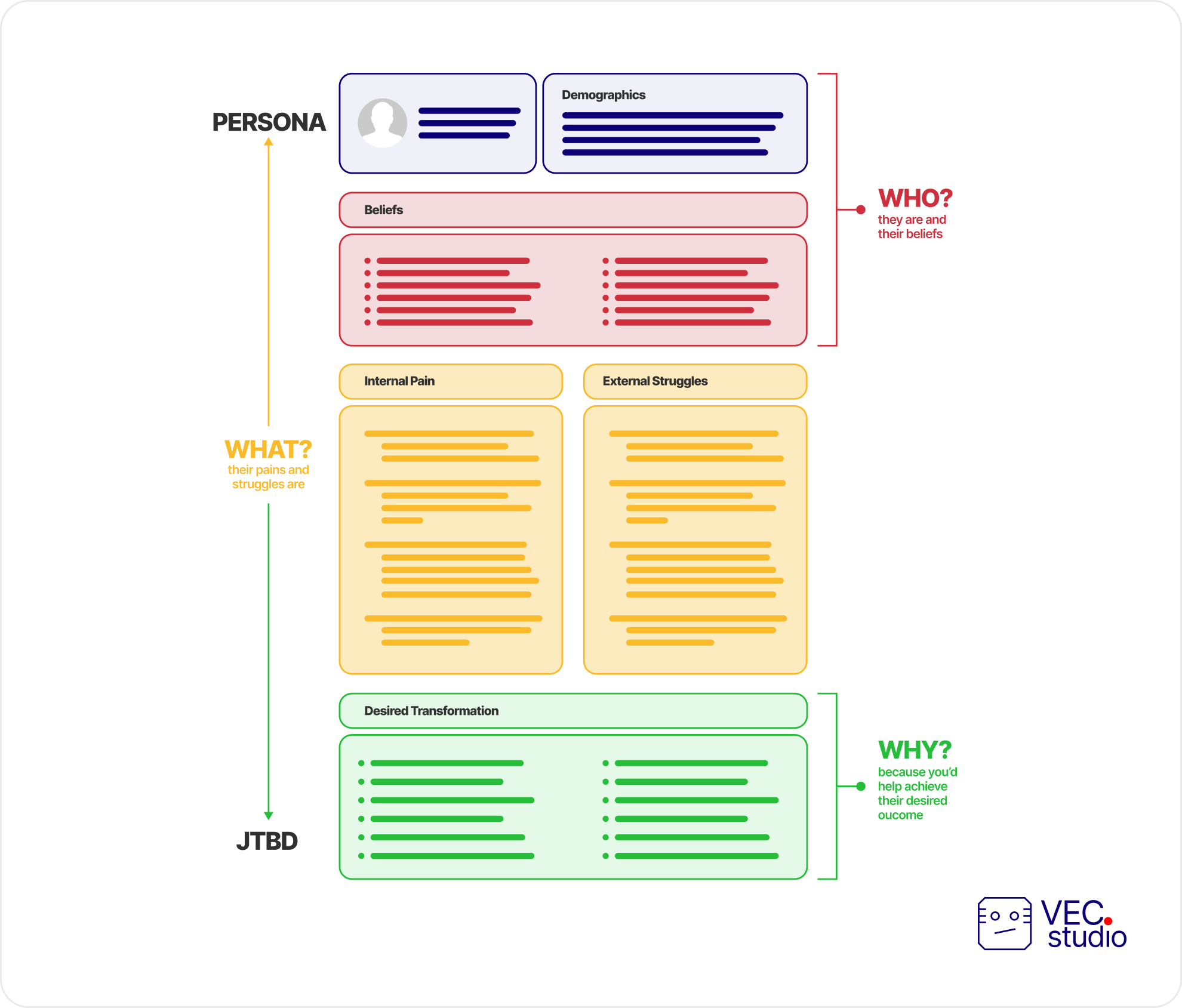
The second challenge was briefing the creation of story-driven, product-led articles. SEO-focused content brief templates are all about stuffing keywords into the outlines of a draft. Because the goal is usually to outrank competitors, there’s little to no room for briefing and outlining the creation of pieces that resonate with readers.
There needed to be a better way.
So we invented StoryBriefs & Outlines:
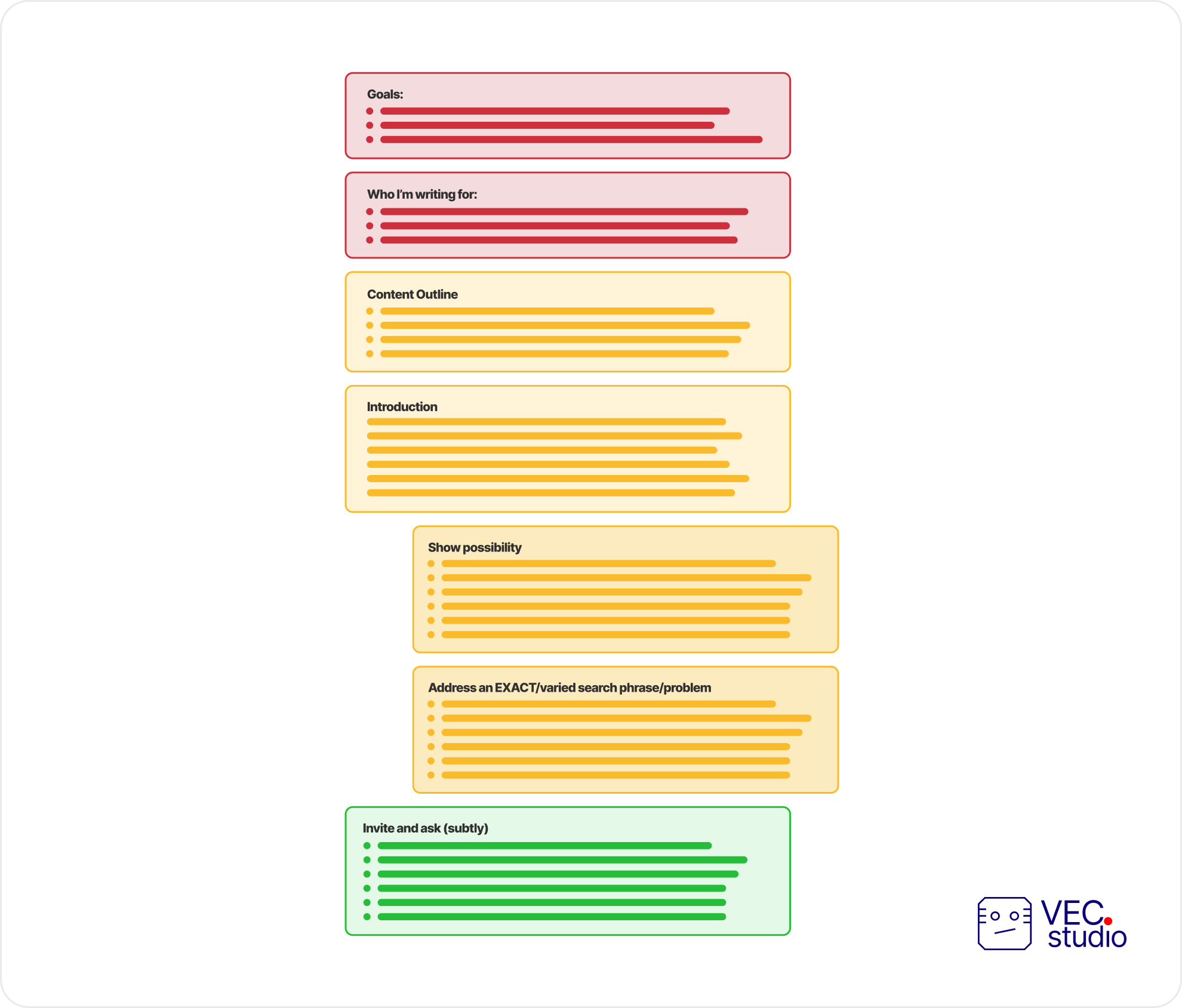
Want to upgrade to these?
I made a step-by-step online course showing how to create and leverage ICP StoryScripts and StoryBriefs & Outlines. The thinking behind them, research processes involved, and all the templates you need.
The course goes for just $200.
Here’s a snippet:
Get lifetime access here.
Start Crafting Product-Led Stories
Recall how I began this essay.
I shared how Ben Horowitz, one of the most influential tech investors alive, went against his stance and invested in NationBuilder. This happened after he saw Jim Gilliam’s story, narrating why he started NationBuilder and why the world needs a tool like his. While this was enough to get Ben’s attention, seeing stories of how ordinary people used NationBuilder to solve problems was the icing on the cake.
It’s what compelled Ben to invest. It was easy for him to picture how other people could use the product. It was easy for him to imagine all the problems the product could solve. And more importantly, it was easy for him to see the potentials of investing in NationBuilder.
The same could be said of your prospects.
They’ll likely only open marketing content or copy if they think it addresses their problem(s). They will only spend 3-15 minutes reading it if the stories used to craft said content resonates with them. And more importantly, they’ll only sign up to trial your product if they see that your product can actually solve their problem(s).
Product-Led Storytelling helps you appeal to both investors and potential customers. That’s because of its execution pillars:
- An overarching company narrative
- A Product-Led Content Marketing Strategy, and
- An obsession over one person (a target buyer) at a time.
Done well, it transforms each piece you craft into a funnel. One that attracts and filters target readers, engages and shows them how your product solves their problems, and persuades them to convert:

Need some help getting started?

Victor Eduoh
Lead Strategist, VEC
Founder, Lead Strategist @VEC. Thinker, reader, words-crafter, and husband to Omosede. Besides crafting product-led stories, I love scouting and grooming rare marketing talents.
Get our insights in your inbox
Actionable summaries of stories told by experts on how they grow brands (and their careers) with content from our Growing with Content podcast. And well-researched insights crafted in the VEC Studio.
I will send you a copy of our Content Quality Checklist –FOR FREE– when you subscribe.

